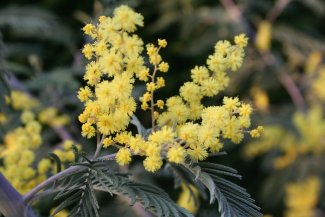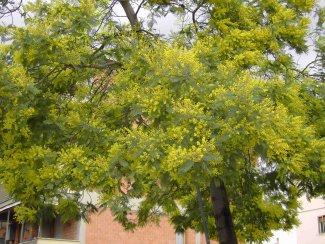AUSTRALASIA - Australia: Australia - Austr. Capital Terr., New South Wales [e. & s.], Tasmania, Victoria
Acacia dealbata (silver wattle) is a tree (family Fabaceae) found in the coastal ranges, San Francisco Bay area, and south coast of California. It favors disturbed places in coastal prairies, riparian areas and coniferous forests. Silver wattle is often confused with green wattle (Acacia decurrens), but is distinguishable by the small, silvery hairs that grow on its twigs. It spreads via rhizomes and seeds, and easily resprouts after being cut. Acacia dealbata changes soil chemistry by fixing nitrogen, and the plants’ fallen leaves may have allelopathic effects that prevent the growth of native understory plants. Unarmed shrub or small tree, to 10 m, but occasionally reaching up to 30 m in height. Leaves grey-pruinose: rhachis bearing glands on upper side, only at the junction of each pair of pinnae. Leaves with c.12-25 pairs of pinnae; leaflets to 5.5 mm, numerous. Flowers bright yellow. Pods not or only slightly beaded.
Like many acacias, silver wattle is commonly planted as an ornamental. Cultivated in Australia, Japan, India, Sri Lanka and South Africa; in Italy and southern France since 1864 and naturalized locally. Experimental cultivation for the essential oil in the Caucasus area. Cultures for production of the tannin containing bark, the gum (component of gum arabic) and of the wood as firewood and tanning material. Collected for extraction of the essential oil of the flowers in southern France. Planted for wind protection in tea orchards and Cinchona plantations.
Acacia dealbata is widely cultivated as an ornamental plant in warm temperate regions of the world, and is naturalised in some areas, including Sochi (Black Sea coast of Russia), southwestern Western Australia, southeastern South Australia, Norfolk Island, the Mediterranean region from Portugal to Greece and Morocco to Israel, Yalta (Crimea, Russia), California, Madagascar, southern Africa (South Africa, Zimbabwe), the highlands of southern India, south-western China and Chile. It does not survive prolonged frost.

